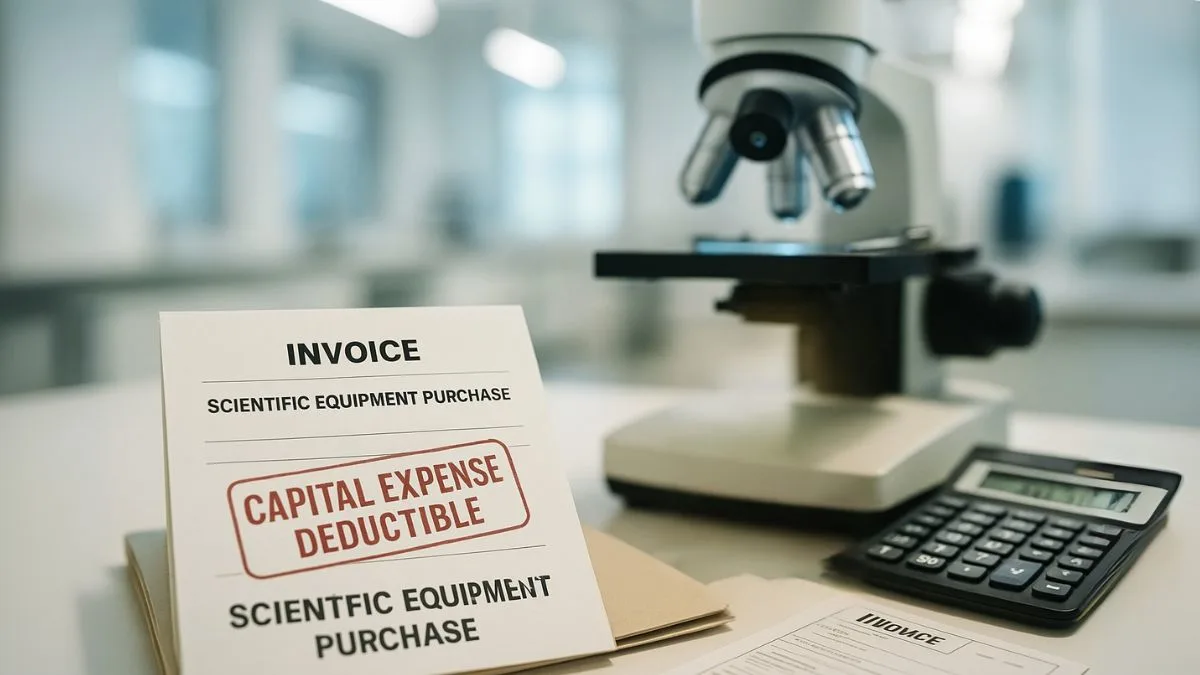
The Indian economy thrives on innovation, and the government has always encouraged businesses to invest in research & development (R&D). One of the most powerful tax incentives provided under the Income Tax Act, 1961 is Section 35, which allows businesses to claim deductions for expenses incurred on scientific research.
While Section 35(1)(i) deals with revenue expenditure, Section 35(1)(iv) is specifically targeted at capital expenditure related to R&D. This means that if a business invests in acquiring, installing, or constructing assets for scientific research, it can claim full deduction under this section.
This article explains what Section 35(1)(iv) is, what kind of capital expenditure is covered, conditions for claiming deductions, case laws, benefits, & compliance requirements.
What is Section 35(1)(iv) of Income Tax Act?
Section 35(1)(iv) provides provisions to cover deductible expenditures on scientific research. It allows a business to claim 100% deductions for capital expenditure incurred on scientific research related to its operations.
In simple terms, if a company sets up a new research facility, buys laboratory equipment, or invests in R&D infrastructure, the entire cost (except the cost of land) can be deducted from its taxable income.
This is a huge benefit, as businesses don’t need to depreciate such expenses over multiple years. Instead, they get an immediate tax shield, improving liquidity & encouraging further investments in innovation.
Key Features of Section 35(1)(iv)
- Type of Expenditure – Only capital expenditure is covered, not revenue expenditure.
- Full Deduction – Businesses can claim 100% deductions in the year of incurring the expense.
- Link to Business – The scientific research must be related to the assessee’s line of business."
- Exclusion – Expenditure incurred on land & building (in some cases) is not deductible.
- Eligible Assessees – Individuals, firms, LLPs, and companies engaged in business can claim this deduction.
Buying lab equipment or setting up a research facility? You may be eligible for a full deduction on capital expenditure — but only if you claim it right. 👉 Click Here
Examples of Capital Expenditure Covered
- Purchase of laboratory instruments & machinery.
- Construction of a research facility (excluding cost of land).
- Computers and IT systems dedicated to research.
- Specialized vehicles used for research purposes.
- Furniture, fittings, & fixtures for R&D labs.
- Cost of patents, licenses, and intellectual property if used for research.
For example, if a pharma company spends ₹2 crores on advanced lab equipment, it can claim the full amount as deduction in the same year under Section 35(1)(iv).
Also Read: Deduction for Revenue Expenditure on Scientific Research
Revenue vs. Capital Expenditure – A Quick Recap
|
Particulars |
Revenue Expenditure (Sec 35(1)(i)) |
Capital Expenditure (Sec 35(1)(iv)) |
|
Nature |
Day-to-day operational R&D costs |
Long-term infrastructure & asset costs |
|
Examples |
Salaries, raw materials, utilities |
Lab equipment, research buildings |
|
Deduction |
100% in year of expenditure |
100% in year of expenditure |
|
Exclusion |
Capital outlay |
Land cost |
Case Laws and Judicial Interpretations
Indian courts have reinforced the taxpayer’s right to claim deductions under Section 35(1)(iv).
- CIT v. Indian Telephone Industries Ltd. – Held that expenses on setting up R&D facilities qualify as deductible capital expenditure.
- CIT v. Modi Spg. & Wvg. Mills Co. Ltd. – Clarified that the benefit is not limited to successful research; expenses incurred genuinely are deductible.
These rulings highlight that the purpose of Section 35(1)(iv) is to promote genuine research, not to test profitability.
Why Section 35(1)(iv) is Important for Businesses
- Encourages Long-Term R&D Investment – Capital-intensive projects often require huge funds. Full deduction reduces the tax burden.
- Improves Cash Flow – Businesses don’t need to spread deductions over years through depreciation.
- Boosts Innovation – Helps Indian businesses compete globally.
- Tax Planning Tool – Immediate deduction lowers effective tax liability.
- Start-up Friendly – Start-ups & SMEs with high R&D costs can leverage this section for tax relief.
Capital deductions are often questioned in scrutiny — proper documentation is the key. Our CA team ensures your claims stand strong. 👉 Click Here
Practical Example
Suppose a biotechnology firm invests ₹5 crores in building a specialized lab & buying high-end research machines. Under Section 35(1)(iv), the entire ₹5 crores (except land cost) can be deducted in the same year.
If the company’s income was ₹20 crores, taxable income after deduction becomes ₹15 crores. At a tax rate of 25%, the company saves ₹1.25 crores in taxes instantly.
Conditions and Documentation Required
- The expenditure must be incurred by the assessee directly.
- Research should be related to the business of the assessee."
- Detailed invoices, contracts, & bills should be maintained.
- Assets must be used exclusively for scientific research.
- Auditor certification may be required in some cases.
Maintaining proper records is crucial since the Income Tax Department scrutinizes large deductions closely.
Integration with Other Sections
Section 35(1)(iv) works in combination with other provisions:
- Section 35(2AB): Provides weighted deduction (earlier 150%) for approved in-house R&D expenditure.
- Section 35(1)(i): Covers revenue expenditure.
- Section 35(2): Explains treatment when such assets are later sold.
This ensures that both revenue & capital expenditure on scientific research are comprehensively covered.
Benefits for Industries
- Pharmaceutical & Healthcare – High spending on lab equipment and trials.
- IT & Technology – Investments in AI, robotics, and cloud research.
- Manufacturing – Process improvements through scientific research facilities.
- Automobiles – Electric vehicle & battery research projects.
- Startups – Innovation-driven businesses can reduce tax pressure.
Also Read: The R&D Super Deduction Every Company Should Know
Conclusion
Section 35(1)(iv) of Income Tax Act is one of the most powerful incentives for businesses investing in scientific research. It provides provisions to cover deductible expenditures on scientific research and allows for 100% deductions of capital expenditure, excluding land.
For companies, this is not just a tax-saving tool but also a way to free up funds for reinvestment in innovation. By taking advantage of this section, businesses can accelerate their R&D efforts and strengthen their competitive edge.
👉 Want to know how to maximize deductions for your business under Section 35(1)(iv) and other R&D provisions? Visit Callmyca.com today – your one-stop solution for tax planning, compliance, and smart business strategies.











